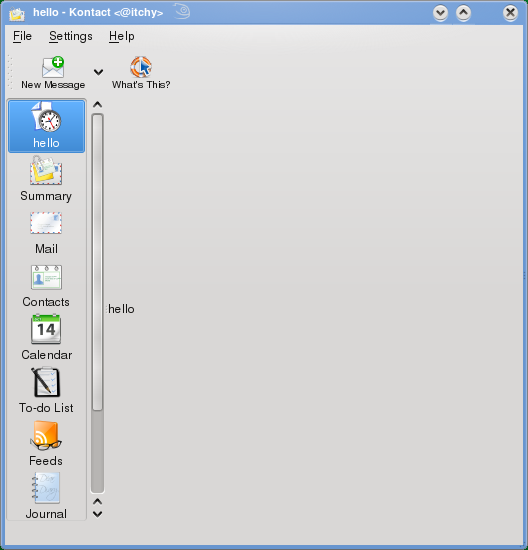Development/Tutorials/Writing kontact plugins
Template:I18n/Language Navigation Bar (zh CN)
Introduction
Kontact is a KDE PIM (personal information management) framework that allows embedding several pim applications like kmail and korganizer as plugins into one window. Kontact plugins use KParts that get loaded at runtime. So, this is a good time to learn how to write a kPart. The "hello world" kontact plugin we will be writing here will look like this:
Writing a KPart
We will write a "hello world"-KPart here. And you will learn how to hold it in a MainWindow. A KPart also gives you the flexibility to be integrated into kontact or konqueror, but we will do this later. So, the "hello world"-KPart only consists of a label "hello world". We chose a label because it is the easiest viewable thing to create. It does not trigger any action. The following is what you do
- write a subclass mypart of KParts::Part
- because setWidget is protected
- use a Widget in it and use setWidget to get your widget into the KPart
- write a subclass mypartmainwindow of KParts::MainWindow
- because createGUI is protected (and you may want createGUI later)
- write main.cpp
- use new mypart(mw) to get your part into your main window
We will use 4 files to do this:
- CMakeLists.txt to ease building work
- mypart.h to declare our classes
- mypart.cpp to implement our classes
Create a directory hello in a fresh checkout of kdepim. In it, add the following files:
CMakeLists.txt
project(hello)
find_package (KDE4 REQUIRED)
INCLUDE_DIRECTORIES( ${KDE4_INCLUDES} . )
include_directories( ${KDE4_INCLUDE_DIR}/kcal ${CMAKE_SOURCE_DIR}/kresources/remote )
set(hello_shared_SRCS
hello_part.cpp
)
set(hellopart_PART_SRCS hello_part.cpp)
kde4_add_plugin(hellopart ${hellopart_PART_SRCS})
target_link_libraries(hellopart ${KDE4_KPARTS_LIBS} ${KDE4_KCAL_LIBS} ${KDE4_KIO_LIBS} kdepim kcal_resourceremote)
if(X11_Xscreensaver_LIB)
target_link_libraries(hellopart ${X11_Xscreensaver_LIB} )
endif(X11_Xscreensaver_LIB)
install(TARGETS hellopart DESTINATION ${PLUGIN_INSTALL_DIR})
install( FILES hello_part.desktop DESTINATION ${SERVICES_INSTALL_DIR})
hello_part.h
#ifndef _HELLOPART_H_
#define _HELLOPART_H_
#include <kparts/part.h>
#include <kparts/factory.h>
#include <QLabel>
/**
* This is a "Part". It that does all the real work in a KPart
* application.
*/
class helloPart : public KParts::ReadWritePart
{
Q_OBJECT
private:
QLabel *mMainWidget;
public:
helloPart(QWidget *parentWidget, QObject *parent, const QVariantList&);
QLabel* MainWidget() { return mMainWidget; };
virtual ~helloPart();
bool openFile(){};
bool saveFile(){};
};
#endif // _HELLOPART_H_
hello_part.cpp
#include "hello_part.h"
#include <kdemacros.h>
#include <kparts/genericfactory.h>
K_PLUGIN_FACTORY(helloPartFactory, registerPlugin<helloPart>();) // produce a factory
K_EXPORT_PLUGIN(helloPartFactory("hello","hello") )
helloPart::helloPart( QWidget *parentWidget, QObject *parent, const QVariantList& )
: KParts::ReadWritePart(parent)
{
KGlobal::locale()->insertCatalog("hello");
// we need an instance
setComponentData( helloPartFactory::componentData() );
mMainWidget = new QLabel();
mMainWidget->setText("hello");
setWidget( mMainWidget );
}
helloPart::~helloPart()
{
}
#include "hello_part.moc"
hello_part.desktop
[Desktop Entry] Name=Friendly Component MimeType=text/calendar; X-KDE-ServiceTypes=KParts/ReadOnlyPart,KParts/ReadWritePart X-KDE-Library=hellopart Type=Service
Compiling your KPart
To compile, link and install the code above, use
cmake . && make && make install
Now you can find your kpart in the local lib folder:
tweedleburg:~/svn/kdepim/hello # ll lib total 468 -rwxr-xr-x 1 root root 471554 May 28 22:42 hellopart.so
And after compilation e.g. in /usr/local/lib/kde4/hellopart.so
And you can find your kpart in the services folder (${SERVICES_INSTALL_DIR} from CMakeLists.txt):
$ ll $(kde4-config --install services)hello* -rw-r--r-- 1 root root 161 May 28 23:33 /usr/local/share/kde4/services/hello_part.desktop
Kontact integration
To integrate your KPart into kontact, you will need to create a subclass of Kontact::Plugin
So, go to your checkout of kdepim, create a folder kdepim/kontact/plugins/hello. Continue there. We will make a shared object file kontact_helloplugin.so and a file hello_plugin.desktop. Those files will be the kontact plugin and tell kontact at runtime which kPart to load (hello_plugin.desktop) and how (kontact_helloplugin.so).
Files
CMakeLists.txt
include_directories(${CMAKE_SOURCE_DIR}/hello)
set(kontact_hello_PART_SRCS hello_plugin.cpp)
kde4_add_plugin(kontact_helloplugin ${kontact_hello_PART_SRCS})
target_link_libraries(kontact_helloplugin ${KDE4_KDEUI_LIBS} kontactinterfaces)
install(TARGETS kontact_helloplugin DESTINATION ${PLUGIN_INSTALL_DIR})
install(FILES hello_plugin.desktop DESTINATION ${SERVICES_INSTALL_DIR}/kontact)
For me kontact_helloplugin is a binary residing in /usr/local/lib64/kde4/kontact_helloplugin.so. hello_plugin.desktop is installed to /usr/local/share/kde4/services/kontact/hello_plugin.desktop.
hello_plugin.desktop
The file kontact/plugins/hello/hello_plugin.desktop tells the kontact plugin which kPart to load. In this case, it is hellopart.
[Desktop Entry] Type=Service Icon=whatever X-KDE-ServiceTypes=Kontact/Plugin,KPluginInfo X-KDE-Library=kontact_helloplugin X-KDE-KontactPluginVersion=7 X-KDE-KontactPartLibraryName=hellopart X-KDE-KontactPluginHasSummary=false X-KDE-PluginInfo-Name=kontact_helloplugin X-KDE-PluginInfo-Version=0.1 X-KDE-PluginInfo-License=GPL X-KDE-PluginInfo-EnabledByDefault=true Comment=The friendly Plugin Name=hello
hello_plugin.h
#ifndef HELLO_PLUGIN_H
#define HELLO_PLUGIN_H
#include <kontactinterfaces/plugin.h>
#include <kparts/part.h>
class HelloPlugin : public Kontact::Plugin
{
Q_OBJECT
public:
HelloPlugin( Kontact::Core *core, const QVariantList & );
~HelloPlugin();
virtual void readProperties( const KConfigGroup &config );
virtual void saveProperties( KConfigGroup &config );
private slots:
void showPart();
protected:
KParts::ReadOnlyPart *createPart();
};
#endif
hello_plugin.cpp
#include "hello_plugin.h"
#include <hello_part.h>
#include <kontactinterfaces/core.h>
#include <kontactinterfaces/plugin.h>
#include <kactioncollection.h>
#include <kgenericfactory.h>
#include <kicon.h>
#include <kparts/componentfactory.h>
EXPORT_KONTACT_PLUGIN( HelloPlugin, hello )
HelloPlugin::HelloPlugin( Kontact::Core *core, const QVariantList & )
: Kontact::Plugin( core, core, "Hello" )
{
setComponentData( KontactPluginFactory::componentData() );
}
HelloPlugin::~HelloPlugin()
{
}
KParts::ReadOnlyPart *HelloPlugin::createPart()
{
KParts::ReadOnlyPart *part = loadPart();
connect( part, SIGNAL(showPart()), this, SLOT(showPart()) );
return part;
}
void HelloPlugin::readProperties( const KConfigGroup &config )
{
if ( part() )
{
helloPart *myPart = static_cast<helloPart*>( part() );
}
}
void HelloPlugin::saveProperties( KConfigGroup &config )
{
if ( part() )
{
helloPart *myPart = static_cast<helloPart*>( part() );
}
}
void HelloPlugin::showPart()
{
core()->selectPlugin( this );
}
#include "hello_plugin.moc"
install your plugin
To compile, link and install your plugin, change kdepim/kontact/plugins/CMakeLists.txt. Include the subdirectory hello like this:
echo "add_subdirectory( weather )" >> kdepim/kontact/plugins/CMakeLists.txt
Then, recompile and install your kdepim
itchy:~/kdepim # make -j4 && make install
Call kontact and you should see an additional plugin.
plugin <-> application Communication
Somehow, your kontact plugin must be able to communicate with your application. For example, if you have a mail application, there will be a need for a button "new mail" in kontact. If this button is clicked, the plugin needs to call a function in the mail application (for corba fans: "needs to send a message to the application"). This is done via dbus. The kontact plugin gets an auto-generated dbus interface provided with the following addition to CMakeLists.txt:
qt4_add_dbus_interfaces(kontact_hello_PART_SRCS ${CMAKE_SOURCE_DIR}/hello/org.kde.hello.hello.xml)
The above example is about the "hello" application.
Integration into kontact's settings
If you want your plugin to be configurable from within kontact (this is needed e.g. to deselect it), have a look into svn how other made this, e.g. here
Beyond hello world
An application around your kpart
To write an application that only contains your kpart, see Development/Tutorials/Using_KParts.
TODO, e.g. user:Tstaerk
See also
- http://api.kde.org/4.x-api/kdepim-apidocs/kontact/html/classKontact_1_1Plugin.html - The Kontact Plugin Interface documentation
- http://pim.kde.org/development/tutorials/creatingplugins.php - tutorial for KDE 3
- http://api.kde.org/4.x-api/kdelibs-apidocs/kparts/html/classKParts_1_1MainWindow.html - the mainwindow where you display your kpart in
- http://osdir.com/ml/python.pyqt-pykde/2005-09/msg00124.html

